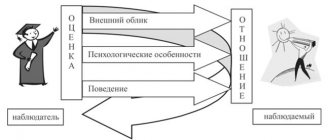The theme of the relationship between teacher and student has ancient roots. Philosophers' thoughts on this topic are presented in the form of short aphorisms: “when the student is ready, the teacher appears” and “the teaching about people is short, but knowledge is long.” Both statements imply a willingness to fully perceive the teacher or people (accurate interpretation of nonverbal communication). The development of perceptual skills occurs according to a certain scenario. Taking them into account, as a rule, helps in many life situations to find a common language with others, and in cases of professional activity of specialists whose sphere of influence lies in the sphere of “person to person”, it increases competence and success.
Meaning of the term
The word "perception" (percipere) of Latin origin literally translates as "perception". This has been known since ancient times, but the question of the development of perceptual abilities is being developed in detail by modern psychology. This fact does not mean that the study of the problem of completeness of perception was carried out fragmentarily. The problem of developing human perceptual abilities gained particular popularity thanks to Gottfried Leibniz. By "perception" he meant "vague impressions" as opposed to apperception - the clear awareness of perception.
In modern psychology, perception acts together with such abilities as thinking, memory, attention and has such properties as:
- perception;
- meaning;
- context;
- objectivity;
- compound.
The scientific study of perception is conducted using empirical methods and models.
Skill formation and development opportunities
All skills are formed in childhood and develop throughout a person’s entire life. Perceptual abilities are no exception. This is the most favorable period in a person’s life for developing almost any skill. Development takes into account the characteristics of the child’s individual development.
In the period from 2 to 6 years, sensory-perceptual abilities are formed and developed. This state of affairs is associated with physiological development and improvement of receptor function. Based on this, two classifications of perceptual abilities were adopted. This is perception by modality (visual, auditory, kinesthetic) and by the form of matter (space, movement, time).
Based on how these (and other) skills are formed at the age of seven, psychologists draw a conclusion about readiness for learning. The fundamental ones are sensory-perceptual abilities, on the basis of which more complex formations arise (social-perceptual and perceptual-reflexive abilities). This mainly occurs after the child identifies himself as an individual and begins to experience various social roles.
It should be noted that if for some organic reason the process of formation of basic skills is distorted (due to impaired vision, hearing, musculoskeletal system and other diseases), then more complex types may not appear or may appear in a distorted form. With normal development, perceptual and reflective skills, like others, can be developed and improved throughout life.
The structure of perceptual action
Any process consists of individual operations - actions. The quality of the result depends on whether they are arranged in the correct sequence and performed without errors.
The process of perception includes a number of perceptual actions, this is due to the fact that a person needs:
Perceptual action is several operations to transform sensory information.
Detection—detects the presence of a cognitive stimulus.
Discrimination - a perceptual standard is formed.
Next, the identification process takes place based on such actions as comparison and identification. The received image is compared with the one in memory and belongs to a certain class of objects, that is, it is categorized.
Mastering perceptual actions is a very difficult and lengthy process for a person, requiring special training.
Development programs and methods
All programs and methods for developing perceptual skills are divided into three groups:
- complexes for children (and adults) with developmental problems;
- for the gifted.
- for children (and adults) with normal development;
They take into account not only intellectual characteristics, but also the age and gender of development of children, adolescents and adults. To determine the appropriate option, you need to read the explanatory note. It describes in detail the target audience, goals and objectives of the methodology or program.
A few words about role principles of behavior
Separately, it is worth mentioning the role principles of behavior. Thus, the role principle of perceptivity is that a person’s role should be positively perceived by his interlocutors, and he, in turn, should positively perceive their interests.
The principle of interactivity is that the fulfillment of a certain role by a person in society should simplify the regulation of the behavior of his interlocutors by influencing his goals and motives. Just like the role principle of perceptivity, it implies that the interests of the interlocutor must be taken into account.
Social significance of the skill
A person gets to know himself, the people around him and the world through communication (verbal and non-verbal). On this basis, the socio-perceptual abilities of the individual are formed and developed. Understanding of the emotional experiences of the interlocutor is formed in preschoolers in the process of communication with significant adults and peers. This necessary component of communication is formed gradually, unconsciously, as an adaptation to the surrounding reality.
Communication is a process consisting of social perception, interaction (exchange of actions) and communication. The exclusion of any component leads to misunderstanding, misinterpretation of intentions, and distortion of contact between interlocutors. If adults consciously work on communication (exchange of information) and interaction almost throughout their lives, the situation with perception becomes more complicated.
The formation and development of social-perceptual skills is influenced by the child’s experience in family situations and associated emotional states. At the same time, the emotions shown by both parents have a great influence on the child. As a rule, the wider the children’s social circle, the more effectively they recognize the emotional state of their interlocutor.
If it happens that an adult’s perceptual skills are not formed at an insufficient level and this fact is a significant obstacle to establishing and maintaining contact, then a lot of time and effort will be required to eliminate the problem. At the moment, special computer programs have been created that help correct the perception of the interlocutor’s emotions based on facial expressions (more precisely, facial microexpressions).
The problems of interpreting human emotional states are described in his books by the famous psychologist Paul Ekman. Since the occurrence of such a problem can significantly ruin a person’s life, special communication training courses, techniques, lists of recommendations and exercises are created.
Who needs to develop perceptual abilities and why?
People who work in the service sector, education, and logistics interact with clients, colleagues, students, and consumers every day. In professional activities, developed perception skills are the key to the successful implementation of goals and objectives. And not only on the professional path.
A developed perception of the interlocutor’s state also plays a huge role at the level of interpersonal communication. Often educated and intelligent people, unable to “read” a person on their own, suffer from distrust and suspicion of others, which interferes with their self-realization and leads to wrong actions and conclusions. After all, a person knows himself through communication with other people. If communication is distorted, the image of “I” undergoes corresponding changes.
It is important that each person has a developed perception of the interlocutor, but the mechanisms and principles for using this ability will be different for all representatives of society.
Functions of social perception
There are several main functions that are implemented within the perceptual side of communication:
- Development of mutual understanding. This function acts as a prerequisite for building productive communication between individuals. Having common interests, sharing the same values and beliefs is the foundation for benefiting from communication. It also makes it possible to find compromises in controversial situations;
- Development of emotional interaction. Feelings and emotions are an integral part of relationships. Positive feelings and emotions create sympathy, negative feelings and emotions lead to hostility.
- Formation of ideas about yourself. A participant in communication can obtain information about himself using conclusions obtained during dialogue with other people. As part of interaction with an interlocutor, a person can relay his attitudes and views on himself. As a result, a person can independently identify what was hidden in his consciousness.
- Formation of ideas about the interlocutor. This is manifested in understanding the views and worldview of people from the immediate social environment. In such conditions, a person can form a complete picture of the interlocutor. There are no alternative ways. Communication acts as the fundamental basis for any type of relationship;
- Organization of joint activities. If people entering into communication understand and accept each other, then this helps them conduct joint activities with a focus on quality results. Knowledge about the interlocutor makes it possible to build a strategy for communicating with him in any situation. Perception takes on a new meaning when it comes to communication on the scale of an entire social group. Productive joint activities can only occur if there is complete understanding and acceptance among group members.
Parents
Perceptual pedagogical skills are the perception and understanding of the state of the interlocutor without relying on verbal information (words). Therefore, every parent who cares for their children has this ability in one way or another. There is a directly proportional connection between “confident” communication with a child and the formation of pedagogical perception in adults.
In early childhood, they are mom and dad who are role models and copy. Therefore, you can often hear the statement that children are a mirror of family relationships. Until the age of three, children unconsciously repeat gestures, words, intonations and facial expressions after significant adults. With this in mind, parents can fully demonstrate their teaching skills in communicating with their child.
Perception in psychology
Perception in psychology is a person’s attitude to the world, which is formed under the influence of information received from the outside through the main sense organs. Translated from Latin, this word means “perception.” The opposite concept is apperception. A person needs to perceive the world correctly, because perception:
- helps to develop the right attitude towards people;
- promotes activation of cognitive function of the brain;
- promotes effective communication;
- makes it possible to correctly evaluate yourself and those around you.
This concept is one of the most studied in theoretical and practical psychology. Perception skills are formed from early childhood, so parents should give their child as much information as possible that can be learned through the senses. This could be music and various sounds, beautiful images, toys for the development of tactile skills.
Educators
In kindergarten, children have experience communicating with peers and adults, who are sometimes more important than their parents. The team of the kindergarten group and parents is a fertile environment for using the perceptual skills of the teacher.
The success of his professional activity directly depends on the ability to perceive in detail the state of his interlocutor and adequately interpret his behavior and intentions. After all, a child’s learning occurs through direct communication with the teacher: in this case, there are no secondary things, everything is important: facial expressions, intonation, gestures, diction, the distance between the interlocutors, the teacher’s competence under discussion, his personal position in relation to reality. After all, only the Personality (through full communication) educates the Personality.
The perceptive ability of a teacher is the ability to perceive the student “as a whole”: with behavioral advantages and disadvantages, features of the development of the psychomotor sphere, communicative and social experience of existing communication. The ability to “separate the wheat from the chaff,” cultivate them and direct them along the path of harmonious development can be considered the talent of a teacher who consciously and indirectly influences children by personal example.
Mechanisms of social perception
The perceptual side of communication consists of a set of tools, with their help a person can establish effective interaction with the interlocutor.
- Reflection is a person’s ability to introspect. With its help, a person can understand how the interlocutor sees him. As part of communication, it is important for us to know how we look in the eyes of our interlocutor, what impression we made on him, and how he perceives our words;
- Identification is a mechanism through which a person can put himself in the shoes of an interlocutor in order to form a view of a problem from a position. This makes it possible to fully or partially share the opinion of the interlocutor and his views;
- Empathy is the ability for genuine sympathy and empathy for another person, based on full understanding and acceptance of the experiences and inner world of the interlocutor;
- Attraction is a mechanism by which a preliminary attitude towards a person is formed. A positive mindset acts as a fundamental basis for creating effective and lasting communication. The attraction is built on common interests and values.
- Casual attribution is a mechanism by which a person can form ideas about the behavior and words of his interlocutors, based on his own assumptions and data obtained during observation.
Teachers
The perceptive ability of a teacher is the ability to:
- monitor the entire class and a specific student at the same time;
- distinguish the characteristic features of a student from the manifestation of a momentary state;
- evaluate student performance based on the performance result (positive, negative, neutral), expressing a comprehensive analysis.
- perceive the student’s psychological state;
It should be noted that the requirements for the skills, abilities and competencies of a teacher vary depending on the field of activity: school, college, university. Different researchers assess teachers' skills differently. The conclusion remains unchanged about the importance of a person’s pedagogical orientation in activity (with a high level of development of general and special skills).
Larisa Maksimovna Mitina in her research emphasizes the reflexive-cognitive abilities of the teacher and his members:
- pedagogical reflection;
- pedagogical orientation.
- pedagogical tact;
All these skills are components of pedagogical culture. It contains important qualities:
- professional knowledge;
- active pedagogical position;
- professional skills;
- professional and personal;
- experience of creative activity.
The value of pedagogical culture is the child - his development, education, protection and maintenance of dignity. The developed perceptual skills of a teacher are the basis for the joint direct activity of teacher and student within the framework of pedagogical culture.
Children of preschool and primary school age
The formation and development of perceptual skills begins in early childhood. This is due to the child’s adaptation to the world around him and the need for development (which does not happen without communication).
Proof of this is Mowgli's children. Since they were placed in the environment of wolves, it was possible to survive only by becoming like them (copying their behavior). This “imitation” launched more complex biological and psychological mechanisms that ultimately prevented children from becoming full-fledged people and reduced life to the life of a wolf.
This example makes us think about the meaning of the environment (emotional, material, sensory, etc.) in which children find themselves. In fact, in infancy, perception is the “engine” of the child’s development.
Teenagers
With age, the role of accuracy and complexity of perception only increases, and the structure becomes more complex. Therefore, the main activity of adolescents is not learning, but communication (a warehouse for the development of perception skills). Ignoring the meaning of communication between teenagers on the part of adults is unacceptable. This is the period of painstaking cutting of the diamond, which is called “communication”. Thus, the teenager gets to know himself, takes an “inventory” of the inner world and completes the formation of the “ego concept.”
Components of the perceptual side of communication
The perceptual side includes a set of processes, among them the following can be distinguished:
- Assessing non-verbal signals transmitted by the interlocutor;
- Observation of behavioral attitudes;
- Formation, based on the information received, of ideas about the inner world of the interlocutor;
- Formation of the subject’s perception on an emotional level;
- Create effective and lasting communication.
The role of perceptual abilities in the life of an adult
In the structure of general personality characteristics, perception is closely related to attention, thought, cognition, sensation and imagination. In everyday life, people with developed perceptual abilities compare favorably with their antipodes. This is expressed in volume, accuracy, completeness and speed of perception, and the emotional coloring of the process. These people are easy to learn, adapt well to the environment, have a creative attitude to work, have their own point of view on current events, and appreciate the weather.
Perhaps, knowing this pattern, employers, in addition to professional tests, would also conduct tests to develop perceptual skills. In a person's personal development, perception also plays an important role. The solution to many problems lies in the area of completeness and accuracy of perception. That's why we are told: "the coffin has just opened" or "it's hard to find a black cat in a dark room if it's not there."
Basic properties and types of perception
Having separated the concept of “perception” and its physiological mechanisms, we can consider the basic properties of perception as a cognitive mental process. The main properties of perception: Subjectivity, Integrity, Continuity, Consistency, Meaning, Reception and Action. Objectivity is a person’s ability to perceive the world not as a set of unrelated sensations, but as separate objects that have properties that cause these sensations. It should be noted that objectivity is not an innate property of perception. The appearance and improvement of this property occurs in the process of ontogenesis, starting from the first year of a child’s life. THEM. Sechenov believed that perception is formed on the basis of movements that ensure the child’s contact with the object. Without movement, perceptual images would not have the same quality as objectification, i.e. reference to objects of the external world. The possibility of object perception is, in fact, determined by the presence of a motor component in the process of perception. This applies not only to visual or tactile perception. This is also common in other conditions. When a person hears a sound or smells a smell, he makes certain orienting movements in the direction of the source of the stimulus. However, as in the case of eye micromovements, these orienting movements are often not implemented by humans. Another property of perception is integrity. The integrity of perception is expressed in the fact that the image of perceived objects is not given in a completely finished form with all the necessary elements, but is, as it were, mentally put together into a holistic form based on a small set of elements. This image is formed conditionally and reflexively through a combination of various sensations. This happens even if some details of the object are not directly perceived by the person at the moment. Or, in other words, the integrity of perception is expressed in the fact that even in the case of incomplete reproduction of some features of the perceived object, the received information is mentally completed into a complete picture of a specific object.
Associated with the integrity of perception is its structure. This is due to the fact that perception in most cases is neither a projection of momentary sensations nor simply a summation of them. What is perceived is actually a generalized structure abstracted from those sensations that are formed over a period of time. For example, when a person hears a melody, previously heard sounds are still ringing in his head when information about the sound of a new note arrives. Usually the listener understands the melody, that is, perceives its structure as a single whole. Obviously, the last melody heard in itself cannot be the basis for such an understanding - the entire melody with the various interrelations of its components continues to sound in the listener’s mind. Perception thus brings into consciousness the phenomena encountered in the real world.
The next property of perception is constancy. Constancy is the relative constancy of certain properties, subjects in the changing conditions of their perception. Thanks to the property of constancy, which manifests itself in the ability of the perceptual system to compensate for changes in perceptual conditions, people perceive the objects around them as fairly constant. Constancy is most expressed in the visual perception of color, size and shape of objects. For example, a lump of coal on a sunny summer afternoon is about eight to nine times lighter than chalk at dusk. However, people perceive its color as black, not white. At the same time, the chalk color will also be white at dusk. It should be noted that the phenomenon of color constancy is due to the cumulative effect of several reasons, including adaptation to the general brightness level of the visual field by light contrast, as well as the perception of the actual color of objects and their lighting conditions. The constancy of the perception of the shape of objects consists in the relative constancy of perception as the position of objects changes in relation to the line of sight of the observer. With each change in the position of an object relative to the eye, the shape of its image on the retina changes (for example, we can see the object directly on the retina, from the side, from behind).
However, the shape of the perceived object remains unchanged. The source of perceptual constancy is the active actions of the perceptual system. Repeated perception of the same objects under different conditions ensures constancy (structure invariance) of image perception in relation to variable conditions, as well as movements of the receptor apparatus itself. Thus, the property of constancy is explained by the fact that perception is a kind of self-regulating action that has a feedback mechanism and adapts to the properties of the perceived object and the conditions of its existence. If perception were not constant, then at every step, every turn, every movement, every change of light, a person would encounter new objects and would no longer recognize what was known before.
Previous perceptual experiences play an important role in the process of perception. Moreover, the characteristics of perception are determined by all previous practical and life experiences of a person, since the process of perception is inseparable from activity. Another characteristic of perception is apperception, that is, the dependence of perception on the general content of our mental life. A person’s knowledge, his previous experience, his previous practice play a large role in apperception. Thus, there are differences in the perception of the same object by different people, depending on the specific task, mood and mental state of each person. This gives an active character to a person’s perception. By perceiving objects, a person expresses his attitude towards them. For example, a person who has little interest in technology usually sees only gross differences in cars of different designs and does not perceive many other design features. Another property of perception is its meaningfulness. Perceptual images always have a certain semantic meaning. As mentioned earlier, human perception is closely related to thinking. The connection between thinking and perception is expressed primarily in the fact that to perceive an object consciously means to name it mentally, i.e. assign it to a certain group, class, associate it with a certain word. Even looking at an unknown object, a person tries to find similarities in it with other objects. Consequently, perception is determined not by a simple set of stimuli acting on the senses, but by a constant search for the best interpretation of the available data. One cannot fail to mention another property - activity (or selectivity). It lies in the fact that at a given moment we perceive only one object or a certain group of objects, while the remaining objects of the real world form the background of our perception, that is, they are not reflected in our consciousness.
Among individual differences in perception, differences in observability are of great importance. Observation is the ability to notice in objects and phenomena things that are hardly noticeable to them, which in themselves are not noticeable, but are significant or characteristic from some point of view. A characteristic feature of observation is the speed with which something insignificant is perceived. For example, curiosity is an important factor in the development of observations. Since we have touched on the issue of observation, it should be noted that there are differences in perception depending on the degree of intentionality. A distinction is made between intentional (voluntary) and unintentional (involuntary) representations. Intentional beliefs are characterized by the fact that they are based on a consciously set goal. They presuppose a certain volitional effort on the part of a person and can exist in the form of organized perception - a purposeful and systematic perception of objects or phenomena in the world. Unintentional perception is a perception in which objects of reality are perceived without a conscious purpose, when the process of perception is not associated with the volitional efforts of a person. Sometimes, however, perception can act as a relatively independent activity. Perception as an independent activity is especially manifested in observation, which is a conscious, systematic and more or less continuous perception that allows one to monitor the course of any phenomenon or changes in the object of perception. Thus, observation is an active form of human sensory perception of reality, and observation can be considered as a characteristic of activity. A person must use all his knowledge to intensify the process of perception, to reflect what is already known about what is perceived. Developed perception helps to receive more information with less energy.










